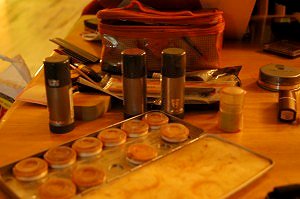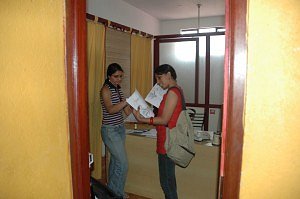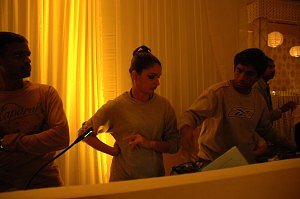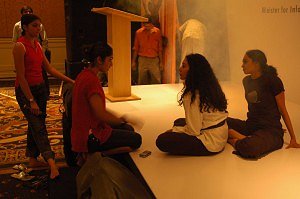
|
 |

|
 |
Show management - Geetha Ballal, Bangalore e-mail: info@nritarutya.com June 6, 2010 The music CD has just slipped and is repeating a track on its own or just goes 'kaput'… '1- 2 -3 -Thud!- the side wing has just fallen on the very spot you were just 2 seconds ago… Ouch!! A nail has just pierced even through the seasoned skin of the feet… How am I supposed to get off the stage when there are no steps?? Oh, oh! My pants have a rip in them, now what? These are just a few glimpses of what can happen to a dancer when on stage, giving a performance. Most often than not, artistes' needs are given last priority when it comes to building a set-up for any performance. Performance is the most intoxicating, high spirited happening in any artiste's life. Every performance, what we call a show, holds a special place, a time that is irreversible. And still, we do not go about checking the little important things that matter to one as a dancer and performer.   With what the dancer has to cope for the dances itself - the steps, the positions and rehearsals, I know with experience that 'show management' in itself is a huge area which we dancers have to be equally skilled to handle to be a better performer. Dancers, whether in a team or pursuing dance career individually, must equip themselves with knowledge on how to manage the process to better their performance and presentation. In my familiarity of handling the production aspects of shows for my company, I know it is very important for a dancer to concentrate on giving that perfect performance. But how can one do it if the mind is cluttered with things that have not been organized? For this, I have a simple mantra - a check list that helps me tick my team's needs for any showcase, so I can be assured that my teammates and I can perform peacefully, thinking only of the dance and nothing else.  It is equally important how we communicate with the organizers to get our needs to be met. A smile on your lips and pep in your voice would be a good start. I've also noticed that communicating freely and clearly help a lot in smooth process of the show. As they say, too many cooks spoil the broth- it is advisable to keep your instructions on your needs clear, short, to the point and made to ONE person who is in contact for the event. At any stage, it would be wise to have all communication through mails and wherever possible a written document - to go back and check on what has been told and compare it to what has actually been done, following which, my basic check list would have the following things: Rehearsal schedule (what to present and how) Once we have a confirmation of the performance, the company accommodates the rehearsal schedule for the sequences to be presented. This is a priority before a show and it requires preparation, probably the one part which we can assure to be 'perfect.'   The next step is to obtain information on the stage size, the flooring and the design of the stage. Get to know the production team in charge to discuss what is available and obtain details of the set-up. This helps in determining the presentation to a great extent. It helps the company to gauge how many dancers can be included in the presentation and modify it accordingly. Any performance is incomplete without the magic of lights; the next step therefore would be to get information on lights that the event is equipped with, based on which suggest additional lights that is specifically required for the show and then work up a rig. Ensure transparency of all communications with the production team to the organizer. Having mails sent on what has been decided also helps. Pre-show (costumes, music, credits) A thorough check on the costumes and accessories is needed for the presentation. A reminder for the dancers to carry their respective gears before a performance is a must. We surely don't want a wardrobe malfunction right in the middle of a performance, nor would we like compromising that arises out of a bad memory now, do we? I strongly recommend carrying a sewing kit too! A check on the music required for the presentation is a must too. Carry the required music in adaptable formats (that plays in all systems, computers or any device that is used for the event). Another important matter to be considered is the credits of the company, its choreographers and dancers. No one wants to dance anonymously - even if I say, our work speaks for itself, people should know who we are, where we are from and what our work is about. It is a dancer's right to be known - don't you think so? - for which I suggest, get introduced to the MC of the event in prior - go with a few notes and help them to fit it into their script. Make sure it is brief and goes with the flow of the event. The look needed for the presentation is yet another important tick mark on the list. Carry good make up to enhance the presentation and when slotting time before the performance, keep a good hour to apply it and get ready. During the show (console management) This involves coordination between the dancers and the organizers on the day of the show at the venue. This mainly revolves around getting a tech-run for the presentation, a mock presentation of the show itself complete with lights, sound and repertoire. While exercising a tech-run, one will need a calm yet convincing approach to get things moving fast, smooth and according to the specified requirement. This section has its own check list: the number of things that needs to fall in place for the tech run, starting with sorting of lights and dancers' positions (yes, this is necessary even if you have a set rig and light designer working for you), the sound level of the monitor, the stage floor being clean and free of sharp objects that may hinder the performance, the exit and entry points, the size and position of green rooms required for changing costumes in-between the presentation, things in the green room like chairs, water, mirrors, the music being played right on time - just few of the long list. At this time, one must be ready to face situations like some of the ones I mentioned in the beginning. Surely, if not for our dancers' excellent presence of mind, we would be facing a decreasing number of the already depleting number of dancers in the city! It is good to have volunteers and helpers during the tech run and performance, who will be available to aid in getting simple things done like cleaning the stage, getting water and refreshments, cue entries, etc. There may be a long waiting period post the tech-run and before the actual performance. Dancers will need refreshments to recuperate - opt for healthy, simple, OIL-FREE snacks along with some warm beverage to get that required strength without feeling too full to perform. Keeping the organizers informed of what can be served beforehand will be useful. Post show We are just off stage after delivering that near perfect 'show' but the story doesn't end there!! Every dancer has to pack their respective costumes/gear, collect the music and thank the crew. I also think carrying a few visiting cards will help - you never know who you will meet for your next collaboration/performance. Back up It is very vital to have back up for every aspect. Main check for this would be back up music cd's. Have atleast 2 - 3 Cds of the repertoire handy to avoid track slipping/not playing sort of issues. Back up costumes is also a good foresight, in case of forgotten costumes or tear/rip that cannot be repaired right then or even if there is an alternate sequence that has to be performed. Medicines - carrying a supply of basic medicines is needed too. Pain killers, band aids, electoral fluids and probably sprays would constitute a good kit. Of course, there are several unforeseen - very last minute - factors that will arise to put one in enough panic to turn the world upside down. But what really works here is a calm mind and quick thinking of an alternative to the situation. Back-ups help you to a great extent at this time. Well, this is by no means an exhaustive list - the list may differ from one performance to the other or even dancer to dancer. With this, one can aim for a near perfect show. I am deliberately saying 'near perfect' as no show can be a perfect one - there are a million 'force majeure' like factors that will glitch, if not the performance, at least the process. There is no sure escape route to a perfect show- but hey, you are a dancer remember - pull up the spine, take a deep breath, put that chest out, focus and…. SMILE. The process too is like a performance… just enjoy it. Geetha Ballal is Assc. Director-Administrator of Bangalore based contemporary dance company Nritarutya. |